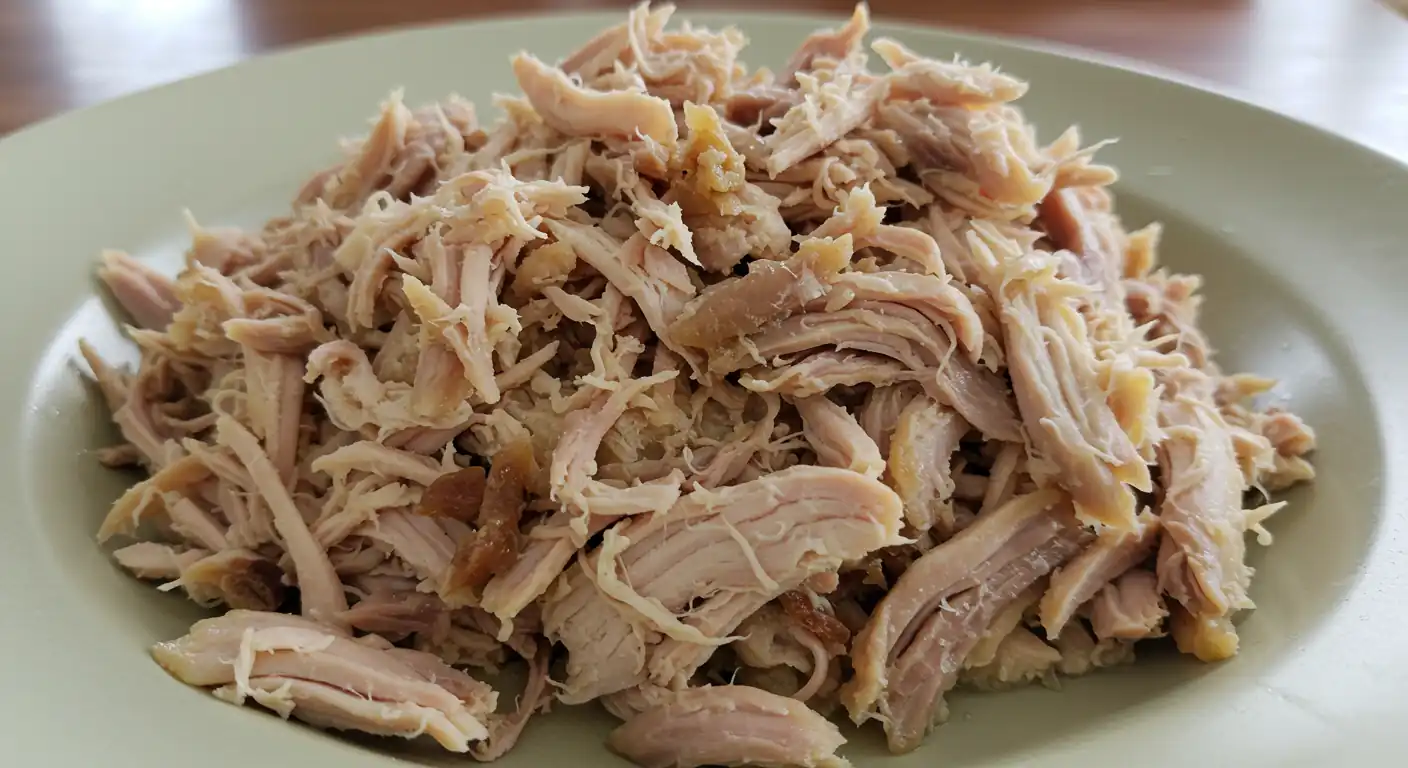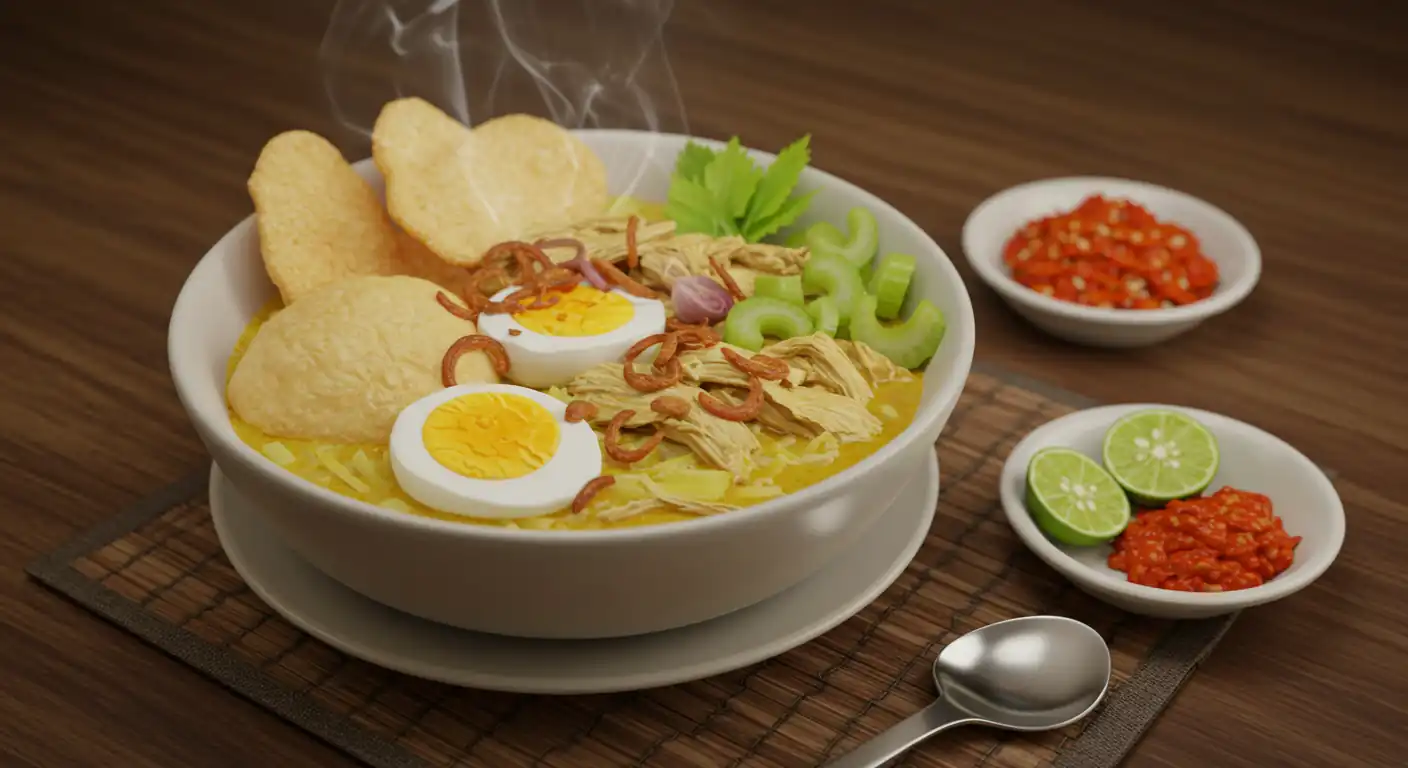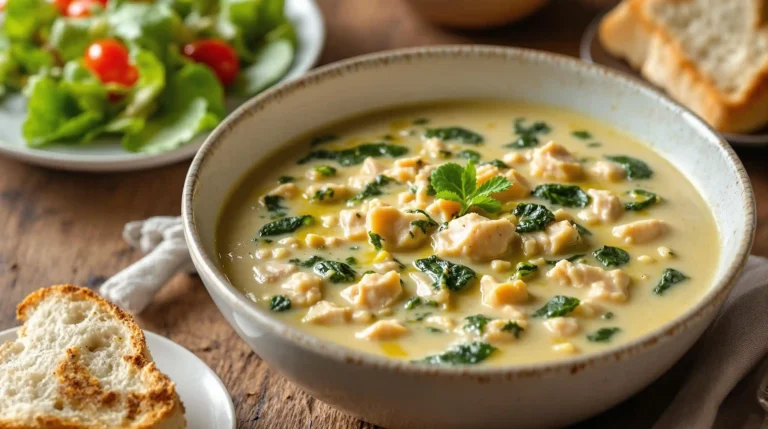Amazing Soto Ayam Recipe: Unbeatable Flavor Explosion!
Ah, Soto Ayam! If you’ve ever craved a bowl of soup that’s bursting with flavour, comforting to the soul, and surprisingly vibrant, then you’ve come to the right place. Soto Ayam isn’t just chicken soup; it’s a beloved Indonesian culinary icon. Found everywhere from street food carts in Jakarta to family dinner tables across the archipelago, this aromatic chicken soup is a staple for good reason.
This guide will walk you through everything you need to know to create an authentic and delicious bowl of Soto Ayam right in your own kitchen. We’ll cover the essential ingredients, step-by-step instructions, and tips to make your Soto Ayam truly sing. Get ready to embark on a flavorful journey to Indonesia!
What Exactly is Soto Ayam?
At its core, Soto Ayam is an Indonesian chicken soup. But that simple description doesn’t do it justice. What makes Soto Ayam stand out is its incredibly fragrant broth, typically infused with a blend of spices like turmeric (which gives it its characteristic yellow hue), lemongrass, galangal, and kaffir lime leaves.
The soup is served with tender shredded chicken, along with a variety of toppings that add texture and complexity. Think vermicelli noodles, crunchy bean sprouts, hard-boiled eggs, fresh celery leaves, and crispy fried shallots. Often, a squeeze of lime and a dollop of spicy sambal complete the picture.
While there are many regional variations (more on that later!), the recipe we’re focusing on today is a classic, widely loved version that captures the essence of Soto Ayam.
Why You’ll Love Making This Soto Ayam Recipe
- Incredible Flavour: The spice paste creates a depth of flavour that’s both complex and comforting.
- Hearty & Satisfying: Packed with chicken, noodles, and toppings, it’s a complete meal in a bowl.
- Customizable: Easily adjust the toppings and spice level to your liking.
- Authentic Taste: This recipe brings the true taste of Indonesian Soto Ayam to your home.
- Impressive Dish: Looks vibrant and tastes amazing – perfect for sharing with family and friends.
Ingredients You’ll Need for Authentic Soto Ayam
Making great Soto Ayam starts with gathering the right ingredients. Don’t be intimidated by the list; many items can be found in Asian supermarkets or larger grocery stores.

For the Chicken and Broth:
- 1 whole chicken (about 3-3.5 lbs / 1.5 kg), or use bone-in chicken pieces like thighs and drumsticks
- 10 cups (2.5 liters) water
- 2 stalks lemongrass, bruised (smash lightly with the back of a knife)
- 4-5 kaffir lime leaves
- 2 bay leaves (Indonesian bay leaves, daun salam, if possible, otherwise regular bay leaves)
- 1 inch (2.5 cm) galangal, bruised (optional, but recommended for authenticity)
- Salt to taste
- 1-2 tsp sugar (optional, balances flavours)
- Cooking oil (for sautéing)
For the Spice Paste (Bumbu Halus):
- 6-8 shallots (or 1 large red onion), roughly chopped
- 4-5 cloves garlic, roughly chopped
- 1 inch (2.5 cm) fresh ginger, peeled and chopped
- 1.5 inches (4 cm) fresh turmeric, peeled and chopped (or 1.5 tsp ground turmeric)
- 3-4 candlenuts (kemiri), roughly chopped (can substitute with macadamia nuts or blanched almonds)
- 1 tsp coriander seeds (or 1/2 tsp ground coriander)
- 1/2 tsp white peppercorns (or 1/4 tsp ground white pepper)
- A little water or oil to help blending
Essential Toppings:
- 200g rice vermicelli noodles (thin rice noodles or bihun), cooked according to package directions
- 1-2 cups bean sprouts, blanched (quickly dipped in boiling water) or fresh
- 2-3 hard-boiled eggs, peeled and halved or quartered
- Fresh celery leaves, finely chopped
- Fried shallots (bawang goreng) – store-bought or homemade
- Lime wedges for serving
Optional but Recommended Toppings:
- Boiled potato chunks or fried potato cakes (perkedel)
- Blanched shredded cabbage
- Chopped spring onions/scallions
- Tomato wedges
- Koya powder (a savoury powder made from prawn crackers and fried garlic – especially for Soto Lamongan style)
- Sambal Oelek or your favourite chili paste
Equipment Needed
- Large stockpot (at least 6-quart / 6-liter capacity)
- Blender or food processor (or mortar and pestle for the traditional method)
- Small frying pan or skillet
- Tongs or slotted spoon
- Fine-mesh sieve (optional, for a clearer broth)
- Serving bowls
Step-by-Step Guide to Making Soto Ayam
Ready to cook? Let’s break down the process of making delicious Soto Ayam.
Step 1: Prepare the Spice Paste (Bumbu Halus)
- Combine all the spice paste ingredients (shallots, garlic, ginger, turmeric, candlenuts, coriander, white pepper) in a blender or food processor.
- Add a tablespoon or two of water or oil to help the blades move.
- Blend until you have a smooth, vibrant yellow paste. If using a mortar and pestle, pound the ingredients until finely ground.

Step 2: Sauté the Spice Paste
- Heat 2-3 tablespoons of cooking oil in your large stockpot or a separate skillet over medium heat.
- Add the blended spice paste.
- Sauté the paste, stirring frequently, for about 5-8 minutes. You’ll know it’s ready when it becomes fragrant, deepens slightly in colour, and the oil starts to separate from the paste. This step is crucial for developing flavour, so don’t rush it!
- If sautéing in a separate skillet, transfer the cooked paste to your large stockpot.
Step 3: Cook the Broth and Chicken
- Place the whole chicken (or chicken pieces) into the stockpot with the sautéed spice paste.
- Add the water, bruised lemongrass, kaffir lime leaves, bay leaves, and bruised galangal (if using).
- Bring the pot to a boil over high heat.
- Once boiling, reduce the heat to low, cover the pot loosely, and let it simmer gently.
- Skim off any scum or impurities that rise to the surface during the first 15-20 minutes for a cleaner broth.
- Simmer for about 45-60 minutes, or until the chicken is fully cooked and tender. The exact time will depend on the size of your chicken.
- Carefully remove the cooked chicken from the pot using tongs and set it aside on a plate to cool slightly. Keep the broth simmering gently.
Step 4: Season the Soto Ayam Broth
- Taste the broth and season generously with salt. Start with about 1 tablespoon and add more as needed. Remember the toppings will add more flavour, but the broth itself should be well-seasoned.
- Add the optional sugar if you like, to balance the flavours.
- Continue to simmer the broth for another 10-15 minutes to let the flavours meld. If you prefer a very clear broth, you can strain it through a fine-mesh sieve, but this isn’t strictly necessary.
Step 5: Prepare the Chicken and Toppings

- While the broth simmers, prepare your chicken and toppings.
- Once the chicken is cool enough to handle, remove the skin and bones (you can discard these or add the bones back to the broth for extra flavour while it simmers).
- Shred the chicken meat using two forks or your fingers. Set aside.
- Cook the rice vermicelli according to package instructions. Drain well and set aside.
- Blanch the bean sprouts by pouring boiling water over them in a colander for 30 seconds, then refresh with cold water. Drain well. Alternatively, use them fresh if you prefer extra crunch.
- Peel and halve or quarter the hard-boiled eggs.
- Finely chop the celery leaves.
- Ensure your fried shallots and lime wedges are ready. Prepare any other optional toppings you’re using.
Step 6: Assemble Your Bowl of Soto Ayam!

This is the fun part! Assembling Soto Ayam is all about layering the different components.
- Place a portion of cooked rice vermicelli in the bottom of each serving bowl.
- Top the noodles with a generous amount of shredded chicken.
- Add some bean sprouts, a halved or quartered hard-boiled egg, and any other desired toppings like potato or cabbage.
- Ladle the hot, fragrant Soto Ayam broth over everything in the bowl. Be generous with the broth!
- Garnish generously with chopped celery leaves and crispy fried shallots.
- Serve immediately with lime wedges on the side for squeezing over the soup, and offer sambal for those who like it spicy.

Tips for the Perfect Soto Ayam
- Toast Whole Spices: If using whole coriander seeds and peppercorns, lightly toasting them in a dry pan before grinding enhances their flavour.
- Don’t Skip Sautéing the Paste: Properly cooking the bumbu paste is key to avoiding a raw spice taste and developing deep flavour.
- Skim the Broth: Removing the scum ensures a cleaner-tasting and clearer broth.
- Taste and Adjust: Seasoning is personal. Taste the broth frequently towards the end and adjust salt and sugar levels.
- Fresh is Best: Use fresh turmeric and galangal if possible for the most vibrant flavour.
- Prep Ahead: You can make the spice paste and cook the broth a day in advance. Store the broth and shredded chicken separately in the refrigerator. Reheat the broth gently before assembling. Prepare toppings just before serving for freshness.
Variations of Soto Ayam
Indonesia is a vast country, and Soto Ayam reflects this diversity with numerous regional variations:
- Soto Lamongan: Originating from East Java, this version is often served with koya, a savoury powder made from ground prawn crackers and fried garlic, which thickens the broth slightly and adds a unique umami flavour.
- Soto Betawi: From Jakarta, this soto is distinct because it often uses beef instead of or in addition to chicken, and the broth is rich and creamy, usually containing coconut milk or fresh milk.
- Soto Kudus: A specialty from Central Java, typically served in smaller bowls, featuring a clearer broth and often garnished with garlic cloves fried whole.
- Soto Banjar: From South Kalimantan, this version uses specific spices like star anise and cinnamon and is often served with lontong (compressed rice cakes) instead of regular rice.
While our recipe focuses on a classic, widely enjoyed style, exploring these variations can be a fun culinary adventure!
Storing and Reheating Leftover Soto Ayam
If you have leftovers (lucky you!), store the components separately for best results:
- Broth: Store the cooled broth in an airtight container in the refrigerator for up to 3-4 days, or freeze for longer storage.
- Shredded Chicken: Keep the shredded chicken in a separate airtight container in the refrigerator for up to 3 days.
- Toppings: Store noodles, blanched sprouts, and eggs separately in the refrigerator. It’s best to prepare toppings like fried shallots and chopped celery fresh when serving leftovers.
To reheat, gently warm the broth on the stovetop. You can add the shredded chicken to the broth to warm through, or warm it separately. Assemble the bowls with fresh or leftover toppings just before serving.
Enjoy Your Homemade Soto Ayam!
Making Soto Ayam from scratch is a rewarding experience. The aroma filling your kitchen as the broth simmers is intoxicating, and the final bowl, bursting with colours, textures, and flavours, is pure comfort. Whether you’re new to Indonesian cuisine or a long-time fan, this Soto Ayam recipe is sure to become a favourite.
So gather your ingredients, embrace the process, and get ready to enjoy a truly delicious and authentic bowl of Indonesian Soto Ayam. Selamat Makan! (Enjoy your meal!)







